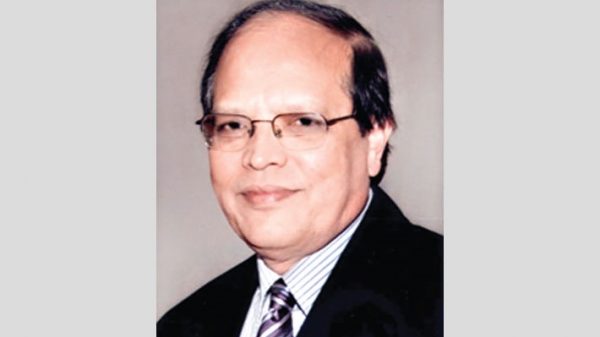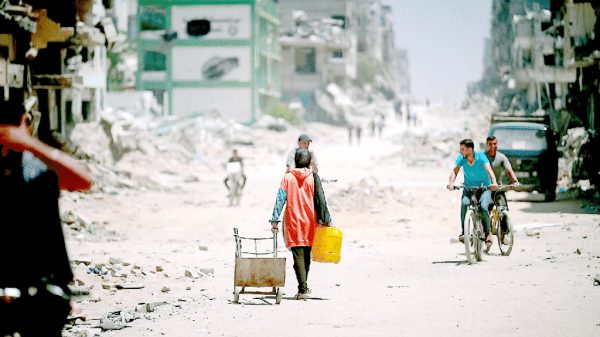As early as 1948, he was fighting for the abolition of the zamindari system without compensation and the rights of reapers to take their share of paddy to home. He was deeply involved in preparing the manifesto of the new party East Pakistan Awami Muslim League, which officially emerged in 1949. Though he was in jail at that time he was still chosen to be the joint secretary of the party.
The party manifesto promised to nationalise the large industries, including jute, along with the end of monopolistic capitalism. It also proposed fair wages for workers and all other facilities for improving their living conditions. In addition, these industrial units were to be run by the state and elected representatives of the workers. It also argued for higher tariffs for imported goods to incentivise domestic industrial production.
His approach to balanced development is also well-reflected in his travelogue ‘New China 1952’ (Bangla Academy 2020) when we see him visiting the industrial units and workers’ colonies and inquiring about the facilities they enjoyed. This theme of social justice continued throughout his political life and was aptly reflected in the pillars of the constitution of Bangladesh.
This constitution provided the basis for a gradual transition to socialism without compromising on the principle of democracy and human rights. While emphasising the state ownership of industries, the constitution also kept enough space for private sector ownership to be guided by the law of the country. In addition, there is another element of ownership in the constitution that belongs to the cooperatives. Bangabandhu was aware of the challenges of implementing socialism within a democratic framework and, therefore, pursued a balanced approach of industrialisation, providing enough scope to small and medium enterprises belonging to the private sector. His short stint as the Minister of Industries and Commerce for about nine months in the provincial cabinet of Chief Minister Ataur Rahman Khan also gave him better exposure to the needs of the domestic industrial sector. He, however, had left the ministry and chosen to remain only as the secretary of the party to make it organisationally stronger, which paid the nation well subsequently.
As the minister, he made a substantial contribution to laying the strong foundation of domestic industrialisation in the eastern wing of Pakistan. Through his strong arguments for supportive policy stance for the natural growth of domestic industries, Bangabandhu made the central government agree to his demands for equal distribution of foreign earnings among the two regions, autonomy in running the industries such as jute, cotton and clothing, autonomy in the issue of export licenses, and establishment of an Export-Import Chief Controller office in East Pakistan, along with the establishment of a Director General’s office in the province. However, the agreement never came to any fruition as the Central Government did not act on it as expected (Abul Kashem in ‘Bangabandhu Nirbhik Rashtranayok: Nirbachito Probondho Shongkolon’, Bangladesh Jatiya Jadughar, 2018, page 37). Bangabandhu also became the chairman of the Pakistan Tea Board in 1956-57 while working as a minister. He expanded the industry and helped increase the earnings from tea. He also established the ‘Research and Production’ committee to help the tea industry. He did not bend to the Central Government’s proposal of establishing a ‘Tea Research Station’ under its jurisdiction, and the station was ultimately controlled by the Tea Board due to his strong opposition to the proposal (ibid. p. 41). This political will for the autonomous economic development of the eastern wing was also rightly reflected in his historic Six-point campaign, which made him the undisputed voice of the Bengalis, despite many hurdles in his political journey. The independence of Bangladesh provided him a legitimate space to make his pledge for balanced and more socially responsible industrialisation a reality.
The First Five-Year Plan laid out all the problems and policies regarding industries that were already under state ownership. Chapter IX of the Plan started with a thorough review of the industrial situation in Bangladesh. It also analysed the current performance of the industries and identified that all major sectors excluding sugar, pharmaceuticals, newsprint, cement, beverages, and processed wood, had experienced a growth in their output during 1972 due to strong public management of the units. Jute, cotton textiles, steel, food and allied products, diesel engines and oil refining experienced a reduction in downturns, propelled by the war of liberation. In addition, sugar, shipbuilding, fertilizer, pharmaceuticals, chemicals, paper, newsprint, cement, and gas experienced an upward trend at the beginning of 1973. Large cloth weaving mills, steel, fertilizer, glass, soap, fish processing, beverage, newsprint, cement, and gas had exceeded or were close to their pre-liberation output levels (FYP, p. 195-198). Of course, there was a limit to these upturns as industrial units could not continue to grow at the initial pace due to a lack of inflow of capital and technological up-gradation in a deeply scarce economy.
The plan then discussed the current situation and problems in the jute, cotton textiles, sugar, steel, shipbuilding and engineering, fertilizer, chemical and pharmaceuticals, forest, paper and board, food and allied products, and minerals industries (FYP, p. 198-204). Chapter 9.2 of the first FYP is titled ‘Problems Affecting Recovery of Industrial Output’. This chapter identified institutional factors, management, labour problems, disruption in linkages, shortage of power, shortage of spares and consumables, finance, loss of market, lack of transportation, and inadequate flow of maintenance imports as the main problems (FYP, p. 205-208). Regarding the objectives of planned investment, the FYP stated, “The government has set for itself the task of realising a level of development where people will be assured of adequate food, clothing, shelter, health care, education, transport and such other basic needs. The industrial plan can only be viewed as part of this endeavour.” (FYP, p. 208). Increasing supply of agricultural inputs, utilising domestic resources, developing capital goods industries, encouraging the growth of indigenous technologies, encouraging small and cottage industries, building up export-oriented and import substitution industries, and balancing geographical distribution were identified as the key ingredients to achieve the objective (ibid. p. 208). The strategy for increasing industrial output was given in chapter 9.5. The chapter suggests re-appraisal and organisation of the nationalised sector. The strategy for the private sector was initially taken not to let its assets expand beyond Tk 2.5 million. The policy would assist the private sector in realising its target and prevent the creation of a big capitalist class. The policy for foreign investment was such that the government would use foreign assistance in the rebuilding of the economy. Geographical dispersion of investment was emphasised to disperse employment and income. Regarding technology, the plan suggested the use of labour-intensive technology in most areas. It proposed to ensure a steady supply of spares and materials which would lead to efficient utilisation of domestic capacity (ibid. p. 209-211).
The Investment Programme and its economic benefits were described in the next parts of the chapter. The economic benefits of the industrial programme included incremental production and production target, value-added from the additional output, employment creation, export promotion and import substitution (FYP, p. 217-226).
Labour policies were discussed in chapter 9.13. The objective of the labour policies was to remove the contradiction between workers and management by ensuring labour representation and developing a spirit of partnership between workers and managers (FYP, p. 257). This reflected Bangabandhu’s determination for a just and socialist society. During his electoral speech on 28th October 1970, Bangabandhu had emphasised the importance of industrial workers in the economy. He said that an increase in the worker’s productivity can be expected if they can receive enough wages to maintain their family, and have a proper home, education and healthcare (D.A.H. Khan, ‘Jatir Pita Bangabandhur Nirbachito Bhashon’, Vol-1, Ekattor Prokashoni, 2018, p. 220).
The role of the private sector was laid out in chapter 9.18. The policy measures for the private sector included the provision of credit, fiscal incentives, industrial estate, technical assistance, industrial association, licensing procedures, and an administrative apparatus for the industrial sector (FYP, p. 268-273). Even though it was not discussed in the plan itself, the national budget for the fiscal year 1974-75 upgraded the investment ceiling to TK. 30 million, along with the scope of privatisation of the abandoned industrial units. This indicates that Bangabandhu’s government was not against expansion of the private sector provided that it did not encourage the concentration of wealth (FYP, p. 277-281). Bangabandhu’s approach towards the development of the private sector is perhaps most eloquently presented in the remarks of Tajuddin Ahmad (Finance Minister of Bangabandhu’s cabinet) at the National Parliament on 30 October 1972, where he said “We intend to encourage private ownership to the extent where it does not allow exploitation and influencing political processes by the private sector.” (Binayak Sen, Bangabandhur Ganatantrik Samajtantra: Bahatturer Shongbidhan o Samatamukhi Samajer Akankha, Tumul Garho Samachar, Episode 73, The Daily Samakal, 25 December 2020).
In his first Independence Day speech, Bangabandhu said that cottage industries were being developed to help alleviate the problem of unemployment in the country. He said that the government was aware of the distinction between urban and rural life and that there would be no inequality between people in Bangladesh. So he emphasised the importance of the equal distribution of wealth (D.A.H. Khan, ‘Jatir Pita Bangabandhur Nirbachito Bhashon’, Vol-2, Ekattor Prokashoni, 2018, p. 190). Bangabandhu was able to identify the importance of small and medium industries long before both China and Vietnam started providing policy support to these industries (Abul Kashem in ‘Bangabandhu Nirbhik Rashtranayok: Nirbachito Probondho Shongkolon’, Bangladesh Jatiya Jadughar, 2018, p. 41-42).
Of course, Bangabandhu’s initial actions regarding industrial development and his five-year plan especially pursued the ‘state led model’ of industrial growth. This was- firstly, due to the absence of national capitalists/entrepreneurs; secondly, because of lack of interest among the existing entrepreneurs to invest in large scale industrial units; and finally, because of his commitment to prevent the emergence of oligopoly in the industrial sector (Binayak Sen, Bangabandhur Ganatantrik Samajtantra: Bahatturer Shongbidhan o Samatamukhi Samajer Akankha, Tumul Garho Samachar, Episode 77, The Daily Samakal, 29 January 2021). But as has been shown in the discussion so far, he intended to ensure controlled growth of domestic capitalists and small and medium entrepreneurs. In a nutshell, Bangabandhu was wise enough to encourage balanced industrialisation under a democratic socialist structure where both public and private sectors would flourish. He also welcomed foreign direct investment for speedy industrialisation in the early 70s, when socialist countries like China, Vietnam or even Russia were not even anticipating such a balanced approach to industrialisation. This only indicates how farsighted he was. His planners under his guidance laid a strong foundation for a thriving multi-sectoral economy by emphasising such balanced industrialisation, which is now contributing more than thirty per cent to the total GDP of Bangladesh. This was not even an upper single digit back in the early 1970s. What a transformation!
The author is Bangabandhu Chair Professor, Dhaka University and former Governor, Bangladesh Bank. He can be reached at dratiur@gmail.com





























Leave a Reply